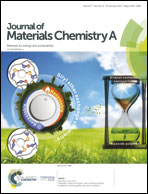Self-healing and superwettable nanofibrous membranes for efficient separation of oil-in-water emulsions†
Abstract
The development of a practical and efficient separation membrane is significant for the purification of emulsified oily wastewater; however, circumventing certain critical limitations such as low flux, membrane fouling and poor durability remains a challenge. Herein, a self-healing and superwettable electrospun nanofibrous and hydrophilic branched poly(ethylenimine)-poly(acrylic acid)/hyaluronic acid (bPEI-PAA/HA, named PPH) membrane was fabricated by adopting a simple strategy combining electrospinning and layer-by-layer assembly. Layer-by-layer self-assembling polymers greatly increase the strength and toughness of the composite membrane. The PAN@PPH composite membranes possess an uneven bulge microstructure with intriguing superhydrophilicity and underwater superoleophobicity as a result of the synergy between the uneven bulge surface and the hydrophilic polymeric matrix. More importantly, the membranes exhibit self-healing properties by repairing damage such as fractures in the presence of water, which significantly enhances their durability and service life in practical applications. This simple but novel and effective membrane system shows promise for large-scale oily wastewater remediation.



 Please wait while we load your content...
Please wait while we load your content...